This one caught my attention the first time I heard it on the radio. It’s even better live. (Even if it’s lip-synced, as it probably was, since the video is from Dick Clark’s American Bandstand.)
August 2023
Fri 11 Aug 2023
Music I’m Listening To: BLONDIE “Heart Of Glass.”
Posted by Steve under Music I'm Listening To[6] Comments
Fri 11 Aug 2023
SF Stories I’m Reading: CONNIE WILLIS “The Sidon in the Mirror.â€
Posted by Steve under Science Fiction & Fantasy , Stories I'm Reading[3] Comments
CONNIE WILLIS “The Sidon in the Mirror.†Novelette. First published in Isaac Asimov’s Science Fiction Magazine, April 1983. Reprinted in Isaac Asimov’s Space of Her Own, edited by Shawna McCarthy (Davis, digest softcover, 1983). Also reprinted in The Year’s Best Science Fiction: First Annual Collection, edited by Gardner Dozois, and The Best Science Fiction of the Year #13, edited by Terry Carr. First collected in Fire Watch (Bluejay Books, hardcover, 1985). Nominated for both Nebula and Hugo awards for Best Novelette of 1983.

Some novelettes by some SF writers are nothing but fluff and padding. On the other hand, there are novelettes by other SF writers that are dense enough to have enough story content to fill two full novels and maybe more. “The Sidon in the Mirror†is one of the latter.
Consider then the protagonist, a pianobar player with two eight-fingered hands who is also the “mirror†of the title, a man who can absorb the characteristics of others – not physically – but their thoughts and inner beings. Sidon is the third largest city in Lebanon, but that may (or may not) be important. In the story, a sidon is an animal having a ferocious unpredictable temper. It cannot be tamed; if you try, it may seem as though you are succeeding, but turning your back on it is not a thought worth considering.
A sidon is also (in the story) what the miners on the all-but-dead star called Paylay (after the Hawaiian volcano Pele?) call their taps into the similarly dangerous gas-mines through the crust and into the core below. The man (mirror), named Ruby by the proprietor of the bar slash brothel, is there (perhaps) on a mission of revenge. It is not clear, but a blind girl named Pearl whom he befriends is somehow the crux of the story.
The crust is thick enough that one can walk on Paylay, but if one stands still long enough, the bottoms of you feet will suffer severe blisters.
So, there you are. Just a hint of who and what this story is about, told in something like Gothic overtones. And at the moment you probably know as much how it all ends as I do, and I have the advantage that I’ve actually read the story. I’ll take that back. I’ve absorbed the story rather than simply read it, and so I’m wrong. I do know more than you do. Until you’ve read it yourself, that is, and I think you should. This is a good one, a story told well beyond the capabilities or visual imagery of a Stanton A. Coblentz and maybe even a Stanley G. Weinbaum.
Way beyond. Like night and day.
Thu 10 Aug 2023
A PI Mystery Review: CATHERINE DAIN – Bet Against the House.
Posted by Steve under Bibliographies, Lists & Checklists , Characters , Reviews1 Comment
CATHERINE DAIN – Bet Against the House. Freddie O’Neal #5. Berkley, paperback original; 1st printing, February 1995.
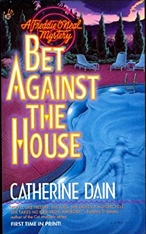
In the wake of such trailblazers as Sara Paretsky, Marcia Muller and (of course) Sue Grafton, all with well-known, successful female PI characters, there came a small flood of other authors and female PI creations, few of which turned out to be either well-known or terribly successful as the ones previously cited.
But Catherine Dain’s series if Reno-based female PI Freddie O’Neal novels lasted for seven, and as they say, that ain’t nothing. Freddie is more in the Kinsey Millhone mold, which if you’re going to be in the mold of someone, you can’t do much better than that. She’s independent, not presently attached, and with a bit of sass to her.
In this one she’s hired to dig up dirt on her client’s mother, who’s inherited all her father’s holdings in a computer chip company, to the dismay of the client and her two brothers who put a lot of effort in making the company what it is today: very very profitable.
Freddie’s problem is that once she meets the mother, who agreed is a little flaky, she likes her. The bigger problem is that when the mother is killed, she finds herself investigating her death, in spite of her usual avoidance of cases where the police are involved.
Dain has a good way with words, which helps the reader immensely in following a case in which the number of possible suspects is really very limited, with the weakest part of the Freddie O’Neal’s investigation being the ending. Oops, you might say, but the fun in this one is in getting there. This one wasn’t a bestseller, but as far as lesser known detective novels with female PI’s go, this one’s one of the better ones.
The Freddie O’Neal series –
1. Lay It on the Line (1992)
2. Sing a Song of Death (1993)
3. Walk a Crooked Mile (1994)
4. Lament For a Dead Cowboy (1994)
5. Bet Against the House (1995)
6. The Luck of the Draw (1996)
7. Dead Man’s Hand (1997)
Thu 10 Aug 2023
Diary SF Review: ANALOG SF – June 1967.
Posted by Steve under Diary Reviews , Magazines , Science Fiction & Fantasy[3] Comments
ANALOG SF – June 1967. Editor: John W. Campbell. Cover artist: by John Schoenherr. Overall rating: ** ½.
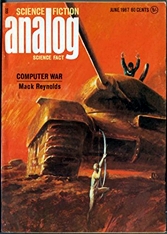
MACK REYNOLDS “Computer War.†Serial, part 1 of 2. See report following that for the July 1967 issue.
LLOYD BIGGLE, JR. “The Double-Edged Rope.†Iron Curtain censorship can “protect†the populace or keep important news from coming out. (2)
JOSEPH P. MARTINO “Security Measure.†A spy inside the USSR finds it necessary that US security measures be declassified to protect Russian missile sites from the underground. Interesting, but not science fiction. (3)
LAWRENCE A. PERKINS “Project Lion.†Analogous to Analog editorials: scientists who don’t know the rules make the greatest discoveries. (1)
CHRISTOPHER ANVIL “The Dukes of Desire.†Novelette in Anvil’s ‘Federation of Humanity’ series. Sequel toâ€Strangers in Paradise†in the October 1967 issue, would not seem to stand well by itself. Roberts and his crew return to that planet with the want-generator to help correct the damage they had done there. They must have a feeling of power along with their altruistic motives, but they manage to get the planet’s population working together again. Fun, if the previous story has been read. ***
Wed 9 Aug 2023
An Archived Review by Barry Gardner: MICHAEL McGARRITY – Tularosa.
Posted by Steve under Bibliographies, Lists & Checklists , Characters , Reviews[4] Comments

MICHAEL McGARRITY – Tularosa. Kevin Kerney #1. Norton, hardcover, 1996. Pocket, paperback, 2004.
This is the second book from Norton that I’ve thought highly of lately; maybe they’re stepping up their crime line. It’s a first novel by a man who became a law enforcement officer for the State of New Mexico while in his forties. He established their first sex crimes unit, and had great success with it. The book was recommended to me by [a good friend of mine], but I went ahead and read it anyway.
Kevin Kerney is the ex-Chief of Detectives for the Santa Fe PD, retired now after being shot up, an embittered man living alone in the New Mexico desert. He’s visited by the cop, a Navajo Indian, who caused him to be shot (by drinking on duty), and the man needs help. His son has gone AWOL from his Army assignment at White Sands Missile Range, and no one can find him.

Kerney is the boy’s godfather, and for this reason alone eventually agrees to look. The trail leads back in history, and then to death and Mexico.
In terms of prose and characterization, this is one of the best I’ve read in a while. My only problem with it came from the fact that it started out to be a detective story and turned into something more of a cowboy story for the second half of the book. A darned good one, mind you, but still.
McGarrity obviously has a love of and a real feel for the desert country of New Mexico, and writes of evocatively of it as anyone this side of Tony Hillerman. I didn’t think a couple; of the villains were fleshed out quite well enough to make them completely believable, but that was one of the few slips I thought McGarrity made. This has the potential to be a very good series.
The Kevin Kerney series —
1. Tularosa (1996)
2. Mexican Hat (1997)
3. Serpent Gate (1998)
4. Hermit’s Peak (1999)
5. The Judas Judge (2000)
6. Under the Color of Law (2001)
7. The Big Gamble (2002)
8. Everyone Dies (2003)
9. Slow Kill (2004)
10. Nothing But Trouble (2005)
11. Death Song (2007)
12. Dead or Alive (2008)
13. Residue (2018)
14. Head Wounds (2020)
Tue 8 Aug 2023
Reviewed by Tony Baer: LEN ZINBERG- Walk Hard — Talk Loud.
Posted by Steve under Reviews[4] Comments
LEN ZINBERG– Walk Hard — Talk Loud. Bobbs Merrill, hardcover, 1940. Lion #29, paperback, 1950.
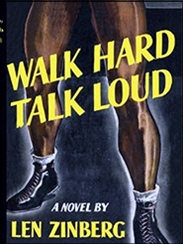
Before he was Ed Lacy, Len Zinberg was Len Zinberg. But he was still writing hardboiled stuff — it just wasn’t marketed as genre paperback fiction. Yet.
This one’s his first novel. And it’s a good first novel. You can kind of tell he’s not exactly sure what he wants to be yet. But he’s got a vision of justice (or a sense of injustice, anyway (which is, to me, better), and he excels at action scenes, especially those involving boxing.
The book follows Andy, a 19 year old Black kid from Harlem. It starts out and he’s scraping for a living with a shoe shine stand. He gets in a rumble with a white kid protecting his shoe shine territory. Andy knocks him out with a short left hook. Looking on, as luck would have it, is a boxing agent.
The agent brings Andy into the gym for a tryout, which he slays, and he signs him to a contract.
Andy’s excited to finally learn a trade. He figures a trade is the one thing that can keep Jim Crow off his back. He’s sick of being judged by the color of his skin. Boxing seems like the real thing. Like Joe Louis. If you’re a great boxer, you can’t be denied. It doesn’t matter your color. Greatness rises to the top.
Plus, once he becomes champ, and makes a bunch of dough, he’ll move away to some country, maybe an island in the Caribbean, where he can escape the racial curses of America and finally be treated like a man.
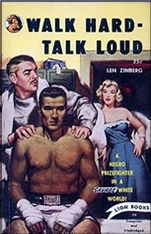
Unfortunately, Andy finds out the hard way that Jim Crow had infested the boxing world too. After losing a fight he’d clearly won to a local white hope, he gets invited to a party by a fellow boxer. The party is being thrown by a NY mob boss, a guy who holds the boxing world in the palm of his hand.
Seeing Andy at the party, the mob boss screams: “I don’t want any niggers at my–” And Andy hit him, a hard right under the chin, and as [the mobster] fell, a fast left cut his nose. There was a terrible stillness in the room and Andy heard his own voice quietly saying, “I don’t like people calling me that.” [The mobster] was sitting up, blood rushing out of his nose and on his expensive shirt. He cursed and jumped to his feet and he had a small black short-barreled automatic in his hand. Andy caught the hand with his right and swung with his left and [the mobster] was knocked against the wall, the gun falling to the floor. Andy kept punching him about the face and “smashed deep into [his] soft stomach — the air whistling out of his bloody mouth, his hands around his belly.”
While it was fun while it lasted, beating up a mob boss isn’t too good for the health of a boxer’s body or career. His boxing career was done. But what was left was the biggest fight of them all: against Jim Crow himself.
—-
It was alright. The best parts for sure were the boxing parts. But there were also some jolting screeds decrying anti-miscegenation (a subject Zinberg knew biblically) and scenes of Django Unchained sized wish fulfillment involving racists and their instant karmic chickens come home to roost.
There wasn’t a lot of didactic lecturing. But there was some, in the form of dialogue with Andy’s love interest, a card carrying communist. Fortunately, she tells Andy that each person has to figure things out for themselves that you can’t lecture somebody into an ideology. A point of view with which this reader gratefully agrees. Nothing bores me like didacticism.
And boredom, says Kierkegaard, is the root of all evil. Now I’m not saying Kierkegaard is right, mind you. Still, I won’t tempt Satan by belaboring the point any further.
Tue 8 Aug 2023
A 1001 Midnights Review: CHARLES DICKENS – The Mystery of Edwin Drood.
Posted by Steve under 1001 Midnights , Reviews[4] Comments
by Mark Johnson
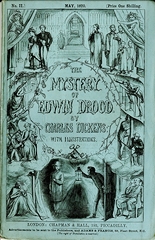
CHARLES DICKENS – The Mystery of Edwin Drood. Published posthumously in 1870. Only six of the twelve projected parts had been completed by the time of Dickens’s death. First published in the US as The Mystery of Edwin Drood, and Some Uncollected Pieces (Fields, Osgood, 1870).
Charles Dickens turned to the pure mystery near the end of his life, and left us, in The Mystery of Edwin Drood, one of the most compelling of all literary puzzles.
Edwin Drood and Rosa Bud, both orphans, were betrothed as children by their parents. Now, as they approach their majority, this arrangement has poisoned the love between them. Edwin is fond of his uncle, John Jasper, the music director of the town cathedral, and his uncle appears fond of Edwin. But Jasper has fallen in love with Rosa, who despises him, and he is consumed by jealousy of his nephew.
Another youth, Neville Landless, admires Rosa and, goaded by Jasper, Drood and Landless quarrel. Subsequently, Edwin and Rosa agree that their marriage would not work and call off the engagement. But before they can announce their decision, Edwin disappears-apparently the victim of murder.
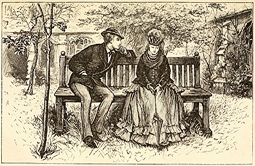
Evidence points to Landless, but there is no case against him because no body has been found. Landless flees in disgrace to London. Rosa, afraid of Jasper, also goes to London. A new character on the scene, known as Mr. Datchery but apparently someone else in disguise, begins dogging Jasper’s footsteps.
At this point, halfway through the projected novel, Dickens died. He left evidence that Jasper was Drood’s killer-but also hinted that there had been no murder. An early working title for the novel was Edwin Drood in Hiding, and some have speculated that Jasper failed in his murder attempt and that Datchery is really the vengeful Drood. There have been many other theories about the novel’s conclusion. One, championed by the late Edmund Wilson (who hated mysteries but loved Dickens), is that Jasper was a devotee of the Indian Cult of Thugs, and that he murdered Drood as a required ritual act. Dickens’s remaining notes are ambiguous, however, and he had promised that the ending would be a great surprise, even to his friends.
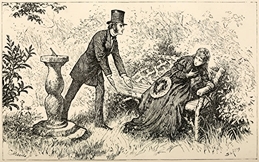
Dickens was a significant figure in the development of the mystery novel long before Edwin Drood. In 1828, when Dickens was seventeen, Robert Peel launched the modern London police force. The young writer was fascinated by the new profession, and in 1850 his magazine, Household Words, published four articles on police work, spawning considerable public interest in crime fighting. In Bleak House (1853), Dickens introduced the intrepid Inspector Bucket, a sort of nineteenth-century Columbo, who was the first fictional English police detective. Dickens was deeply influenced by his friend Wilkie Collins, whose classic novel The Moonstone was published in Dickens’ periodical All the Year Round in 1868.
———
Reprinted with permission from 1001 Midnights, edited by Bill Pronzini & Marcia Muller and published by The Battered Silicon Dispatch Box, 2007. Copyright © 1986, 2007 by the Pronzini-Muller Family Trust.
Sun 6 Aug 2023
Reviewed by David Vineyard: ARTURO PEREZ-REVERTE – What We Become.
Posted by Steve under Reviews[3] Comments
ARTURO PEREZ-REVERTE – What We Become. Spanish title: El Tango de la Guardia Vieja. Atria Books, US, hardcover, 2016. Washington Square, US, softcover, 2017.

There comes a time when I want to settle down with a sweeping romantic novel, mind you not a Romance novel, nor a Gothic novel, nor yet a love story. The Romantic Novel need be none of those things. Instead it is a broader definition of romance, of travel to exotic locations, adventure, of high personal stakes and of human emotions under pressure.
Arturo Perez-Reverte, the bestselling Spanish writer whose novels The Club Dumas (filmed as The Ninth Gate with Johnny Depp), The Seville Connection, and his books about Spanish Renaissance era mercenary soldier Captain Alariste (a two hour film with Viggo Mortenson and a streaming television series) are virtually the definition of a modern Romance novelist, particularly works like The Nautical Chart, The Fencing Master, The Siege, and Queen of the South, which has become a popular international streaming channel hit and remains one of my personal favorite modern novels.
It is almost impossible to read Perez-Reverte and not think of old Warner Brothers films and Bogart or Cary Grant with Ingrid Bergman or Lauren Bacall a lush Max Steiner score and Peter Lorre and Sydney Greenstreet lurking in the background.

With What We Become Perez-Reverte gives us a tale with echoes of Casablanca, Notorious, and To Catch a Thief that spans across multiple decades as two lovers cross paths at different crisis of their lives and that of the world around them.
The lovers are Max Costa and Mercedes (Mecha) Inzunza. Max, a suave thief (eventually Legionaire, deserter, spy, con man, and poseur) is crossing the Atlantic to Buenos Aires on a luxury liner, working his way across dancing with wealthy passengers.
Among those passengers is Mecha, a young bride of a famous composer, Armando de Troeye, who finds herself swept away during a tango by the dashing thief and plunged into a passionate if short love affair in decadent 1928 Buenos Aires. That affair ends as suddenly as it began.
They meet again in 1937 in Nice in the shadow oncoming world war and renew their passion briefly as Max crosses the path of a Spanish spy and again their love affair is cut short.
Finally an aging Max and Mecha meet in Sorrento twenty-nine years after they first met in the shadow of the Cold War where his passion for Mecha, her adult son (who undoubtedly has Max’s smile) there for a chess match with a Russian master, and Max subtly blackmailed by Italian agents, though he is too old for the game.One last theft ties them all together and one last temptation and salvation of sorts.

Part Eric Ambler, part Graham Greene, with Perez-Reverte’s uniquely Spanish voice coloring the tale, the book is by turns erotic, kinky, elegant, brutal, violent, suspenseful, and evocative of a Europe that once was of nervous borders crossings, great poverty, and great wealth, moving from the glamour of pleasure palaces to seedy clubs and seedier assignations (Lions at the Kill wasn’t a bad name, but it promised more than it offered.) evoking Harold Robbins or Sidney Sheldon one instant and Alexandre Dumas pere or Raymond Chandler the next without missing a beat.
Arturo Perez-Reverte has yet to disappoint me, whether hinting at something diabolical in the old book trade, uncovering secrets in an ancient church, exploring the international drug trade, swashbuckling through the Inquisition, pitting a fencing master against his deadliest student, investigating a serial killer in the middle of a city under siege, or taking on a Conradian treasure hunt his voice and style are unique, his style evocative of past masters and defiantly unapologetically and gloriously literary, new, and literate.
I can’t promise you, but I don’t think you will ever hear “The Man Who Broke the Bank at Monte Carlo†quite the same way after you meet Max.
Sat 5 Aug 2023
ROCKWELL KENT – N by E. Brewer & Warren, hardcover, 1930. Blue Ribbon Books, hardcover, 1933. Wesleyan University Press, hardcover, 1996.

True adventure story told in the form of journal entries from January through September 1929. Each entry is illustrated by original woodcut prints by the author.
The adventure begins when he agrees to join the three-man crew aboard a wooden sailboat, set to sail from New York Harbor to Greenland by way of Newfoundland and Labrador.
They make it nearly to the shores of Greenland when:
“We lay, caught in the angle of a giant step of rock, keel on the tread and starboard side against the riser; held there by wind and sea; held there to lift and pound; to lift so buoyantly on every wave; to drop—crashing our thirteen iron-shod tons on granite. Lift and pound!….A giant sledge hammer striking a granite mountain; a hollow hammer; and within it a man. Picture yourself that man. I stayed below, and was…..set full blown into that pandemonium of force, his world — of wind, storm, snow, rain, hail, lightning and thunder, earthquake and flood, hunger and cold, and the huge terrifying presence of the unknown…..We live less by imagination than despite it.â€
The author, of course, lives to write this tale. The ship is not so lucky. Yet so beautiful to gaze upon “the mountains, at the smoking waterfall, at the dark green lake with wind puffs silvering its plain, at the flowers that fringe the pebbly shore and star the banks†that the sunken sailors can only proclaim that: “It’s right…that we should pay for beautiful things. And being here in this spot, now, is worth traveling a thousand miles for, and all that that has cost us. Maybe we have lived only to be here now.â€
He comes to see the lost ship as a gift: “Only those men who have through shipwreck, drunkenness or chance achieved such a loss have tested freedom; and in a world inclined to tame the wilderness and eliminate the hazards from experience we may well cling to the ancient, high born, salutary privilege of man — of getting, sometimes, drunk.â€
The sublimity on the terrain shakes his very being. “Not until darkness is at hand do I prepare my supper, for even these long days are far too short for all their beauty. Suddenly — it is now dark — a prolonged, high-pitched barking breaks the stillness; turning my eyes to the sound I see, silhouetted against the sky on the dark ridge of the hillside, a little blue fox. He sticks his sharp nose up at Heaven and for an hour howls away.â€
Fusing with a land where nature still dominates over ‘civilization’, he learns that “Man is less entity than consequence and his being is but a derivation of a less subjective world, a synthesis of what he calls the elements…and thus the elements at work become for man the pattern of his conduct… sunshine and storm, peace and turmoil, lightning and thunder and the quiet interludes…. But in the wilderness invariably peace predominates; and seeing the quiet uneventfulness of lives lived there, their ordered lawlessness, the loveliness and grace of bearing and of look and smile that it so often breeds and fosters we may indeed lament what man has made of man and hold those circumstances of congestion which are called civilization to be less friendly to beauty than opposed to it.â€
It is a strange adventure novel that keeps on going once the adventure ends. And here, the adventure and the propulsion of that narrative thrust drowns with the ship. Yet once the ship sinks, a new experience arises: that of a man forced back to nature. And rather than fighting it, accepting it. Rather than molding the land, letting the land mold him. Like Thoreau were his pond the Atlantic. Were Concord Greenland.
The prose was difficult for me. It is frequently languorous and liquid, where I prefer the hard rocks that dash experience into shatters, that break everything upon its shores, into arrowheaded shards.
Yet the name of the ship here was “Direction†— a name of which the author lamented its hubris. And as Direction sinks, the author’s spirits rise in the directionless peace of a pilgrim in reverse, from new world to old primordial lands of Icelandic saga, Native naivete, yearning less for rescue than escape.
Some of the amazing woodcut images which compliment the narrative and provide more and better adjectives than those found in any thesaurus, can be found here and here
Fri 4 Aug 2023
An Archived Movie Review: GENTLEMEN PREFER BLONDES (1953).
Posted by Steve under Films: Comedy/Musicals , Reviews[7] Comments
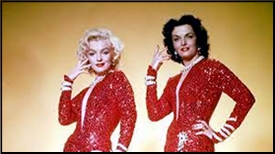
GENTLEMEN PREFER BLONDES. 20th Century Fox, 1953. Jane Russell, Marilyn Monroe, Charles Coburn, Elliott Reid, Tommy Noonan, George Winslow. Based on the musical comedy by Joseph Fields and Anita Loos. Director: Howard Hawks. Currently streaming online here.
Especially if the blonde is Marilyn Monroe. Jane Russell is the brunette of the pair, showgirls with two tally opposed ways of looking for a husband. Lorelei Lee is a golddigger from the word go, while her friend is looking merely for a man.
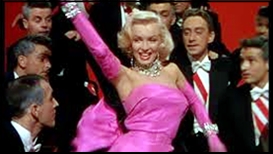
There is not much to the story. Subtract the singing and dancing, and you’d have an hour or less of plot, which nobody probably pays any attention to anyway. Marilyn steals the show as the really not-so-dumb blonde. She has all the moves in the book.